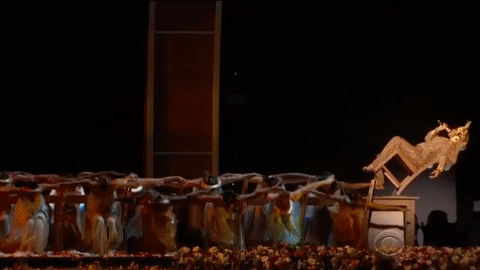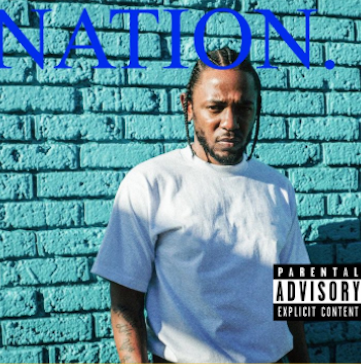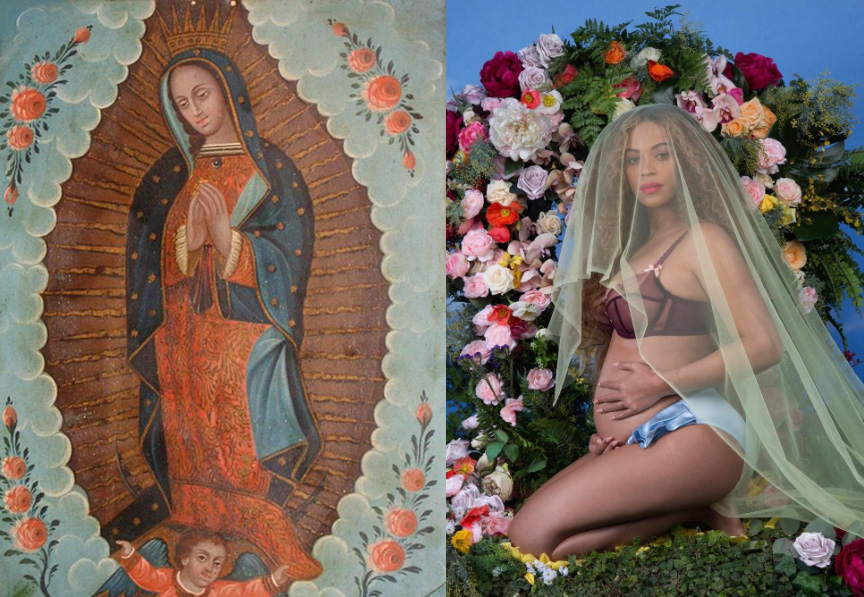
Examining pop music’s fascination with death and rebirth in 2017
by Nat Pitcher
Each morning when my phone alarm rings, rather than open my eyes and hit the snooze button like a regular person, I keep my peepers squeezed shut, and jab the screen randomly till my finger finds the right spot. This is because each day when I wake, I fully expect nuclear war to have broken out, and I know there will be an ABC news alert (plus a million Facebook notifications) on my lock screen to tell me so. 7am is just too early to deal with that information. If the world is going to go to pieces, so be it, but let me start my last normal day in short-lived peace.
While global events have taken a precipitous slide in the last few weeks, things have been a little ~touchy~ for quite some time now. And like less majestic, featherless ostriches, we humans tend to bury our heads in the safe, cosy sands of culture (both high and low) as a means of escape when things in life get a little too real. I’ve been indulging in the latter kind of escapism for the last several months, and I’m noticing a bit of a pattern. Our pop cultural icons are turning into idols. Yes, the deification of cultural figures isn’t really new, (*cough* Madonna *cough*), but seems like this imagery is taking over the pop culture landscape. Let’s examine the evidence.
February 2
It begins with Beyoncé’s famed pregnancy announcement, posted on Instagram on February 2nd. Shot by Ethiopian conceptual artist Awol Erizku, the expectant mother kneels on perch of ivy in front of an elaborate arrangement of roses, poppies and ferns, serenely cradling her twice-blessed belly. Though hyper-stylised (she’s draped in acid-green veil and set against a shockingly blue backdrop), people were quick to draw parallels with Venus, the Virgin Mary, and the Patroness of Mexico, The Virgin of Guadalupe.
February 12
Two weeks later, she performed at the 2017 Grammy awards in a spectacle where the religious themes hinted in the announcement were even more pronounced. She wore an ornate Peter Dundas gown which took 50 people to embroider, and in a move that no-one but Beyoncé could pull off, the focal point of the gown was a gilded embellishment of her own face, smiling benevolently over the cherubs placed on each of her hips. Each sleeve glittered with beaded words, together spelling ‘uncontained devotion,’ and atop her head sat a crown of stylised sun rays. While fans some were again making comparisons to Christian figures, the references in this performance were much more global. The emphasis on the colour gold and sun-ray symbolism was more Oshun than Our Lady. An Orisha of the Yoruba (an African diaspora belonging to present-day Nigeria and southern Benin), Oshun is symbolic of love and fertility, and an apt embodiment for an expectant Queen Bey. She is said to be the protector of the poor and the mother of all orphans; a healer of the sick; the bringer of song, music and dance; and teacher of culture and mysticism.
Her dancers’ movements, evocative of rising tides and flowing waters, nod to the African water spirit Mami Wata, or Mother Water, and the Hindu goddess, Kali, is also referenced in the projections of Beyoncé with many arms, evoking the goddess associated with death, sexuality and motherly love.


This is not the first time Bey has embodied heavenly figures – 2016’s visual album Lemonade is steeped in imagery borrowed from the religion, mythology, and history of African diasporas. In the clip for “Sorry”, she intermittently appears as Nefertiti and painted in Ori of the sacred Yoruba tradition. In the clip for “Love Drought”, a row of women walk into the sea, hands joined and raised in the air, a powerful evocation of the Igbo landing of 1803, where 75 prisoners chose death over slavery. Oshun, again, is all over Lemonade. As the Orisha who has suffered the most — a victim of abuse, neglect, and loss — it’s fitting that she’s the main inspiration for a record about infidelity and betrayal.
The Yoruba culture, in particular, is having a moment of mainstream cross-over in 2017, with emerging artists like Princess Nokia (Destiny Frasqueri) flaunting their heritage in their work. Similar to Beyonce’s re-appropriation of culture in Lemonade, Nokia’s track BRUJAS celebrates her Afro-Puerto Rican culture, featuring rituals from the Taíno and Yoruba traditions.




April 14
If Beyonce is the queen of the pop cultural moment, then Kendrick Lamar is her royal counterpart. His fourth studio album, DAMN, was released on April 14, coincidentally (or not), also Good Friday. (Do ya see where I’m going with this?) You would think that the 55-minute, 14-track album would be enough to satiate fans, at least for a little while.
Especially considering the consistency of his output – delivering at least a mixtape, if not an album, each year since 2011 (with the exception of 2013). But alas, we millennials are a greedy bunch. As soon as DAMN dropped, Reddit’s hip-hop threads were atwitter with theories that an accompanying second album’s release was imminent. To be fair, Frank Ocean’s double-drop of Endless and Blond the previous year proved it was possible – but then again Frank had four years to work on it.
It was prophesied that the follow-up would be titled NATION, which together would make DAMNATION. Of course, in retrospect, this all seems ludicrous. But if you indulge your inner conspirator, there was some pretty compelling evidence to be found:
First of all, the release date. Given the religious overtones in the film clip for HUMBLE and the fact that DAMN dropped on the date when Christians believe Christ was killed, it seemed only fitting that Christ-like, Kendrick would rise again on Easter Sunday with the second release. There’s also the focus on duality throughout the album, with track titles like “BLOOD / DAMN,” “PRIDE / HUMBLE,” ” LUST / LOVE,” “FEAR / GOD”.
Adding fuel to the fire, there’s the curious placement of the title on the album artwork, which just so happens to make the ‘M’ of DAMN appear like devil horns over Ken’s face. The awkward positioning is enough to make any typographer’s toes curl, so surely this was a considered move, rather than plain old bad taste.


As Reddit user tyrant89 pointed out, Kendrick has a predilection for the colour combination of red and blue and notes that the absence of the latter from the album imagery seems suss. Fans speculated that the mysterious acronym “TOC” mentioned in the stand-alone track “The Heart Part IV,” released earlier in 2017 could mean ‘the other colour’ i.e. BLUE. Here’s where things get ~interesting~. The night of DAMN’s release, Kendrick changed his profile picture on Spotify from the above image with the red brick background to one of him standing in front of a blue brick wall. As one Photoshop-happy fan demonstrated, if the second album’s title was indeed to be NATION, this blue image could be the cover art, and some clever placement of the title could make the ‘O’ appear as a halo, mirroring the devil horns on DAMN:



Obviously, none of this actually eventuated. But for a society that is less religious than ever before, what does it say about us that we are so thirsty for these familiar, biblical narratives that we would fabricate such an elaborate theory?
June 30
In DAMN, Lamar spends a lot of time contemplating life, death, and his relationship with God. The same themes crop up in Jay Z’s anticipated 4:44, released on June 30. The opening track, “Kill Jay Z”, makes it clear that’s he’s spent the last two years coming to terms with wrongdoings Bey accused him of in Lemonade. In chapters within the song, “Kill Jay Z / Fuck Jay Z / Die, Jay Z / Cry, Jay Z,” we hear J-Hova working through the impact past trauma has had on his behaviour, urging himself to become ‘softer’ for his daughters, and acknowledging he wasn’t big enough to own up to his mistakes. Ending with the line, “Nah Jay Z / Bye, Jay Z,” you get the sense that he’s really sick of having these conversations with himself, to the point where he’s ready to shed the skin of the old Jay Z once and for all.
July 13
A month after the birth of their twins, Jay and Bey unveiled them to the world via another high-concept shoot by Erizku. The same spiritual overtones are present, evoking incarnations of the feminine divine from multiple beliefs and cultures. From Madonna and child(ren) to Botticellian goddess, in combining these icons, she’s very deliberately challenging the Madonna/whore complex by embracing both her sensual and maternal sides.


August 25
Skip ahead a few weeks, and we have Taylor Swift joining the reinvention club, announcing the new era with the song and film clip for “Look What You Made Me” Do on August 25. A few days earlier, the pop star deleted all posts from her Instagram, Facebook, and Twitter accounts. At the time fans were bamboozled, but all became clear with the line from the track “I’m sorry, the old Taylor can’t come to the phone right now. Why? Oh, cos she’s dead!” There’s Zombie Swift. There’s Country Bumpkin Swift. There’s even a kinked-up dominatrix version of Squad Leader Swift. The reborn Taylor lords over them all, with a neon T glowing like a decapitated crucifix behind her. There are so many references to the death and rebirth of the country sweetheart/wholesome pop princess/wannabe feminist icon that it doesn’t hit you over the head so much as blow it clean off your neck with an ‘I <3 TS’ t-shirt cannon.




So what is actually going on here? Studies and polls over the last few years have consistently shown that Western countries are becoming less religious (less Christian in particular), with the UK, Australia, Sweden and even the US reporting declining rates of religious affiliation. If this is the case, then why are these themes of resurrection and rebirth resonating with audiences so strongly? Is anxiety from the threat of nuclear annihilation causing us to project the desire for salvation onto our pop culture idols, the closest thing we currently have to gods on earth? Whatever the reason, these gods among us are giving us exactly what we want, and making a nice bit of coin from it too.



